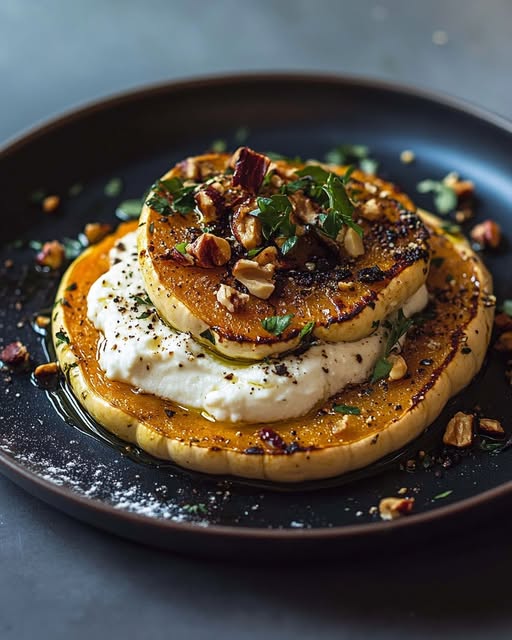
Picture this: a cozy Sunday evening, the house filled with laughter and the aroma of something sweet and savory roasting in the oven. That’s exactly what happened when I first made Sumac Roasted Squash. This dish quickly became a family favorite. The tangy sumac, sticky honey, and creamy labneh create layers of flavor that feel indulgent yet comforting. And guess what? It’s as easy to make as it is delicious. Whether you’re hosting a dinner party or just want to impress your loved ones, this recipe will do the trick.
A Little Background on Sumac Roasted Squash
Sumac, with its vibrant red hue and citrusy tang, has been used for centuries in Middle Eastern cooking. It adds brightness to dishes without overpowering them. When paired with roasted squash, it creates a balance of sweetness and acidity that’s simply irresistible. This dish is inspired by Middle Eastern flavors but feels modern enough to fit into any international menu. I first stumbled upon this combination while experimenting with seasonal produce. The result? A dish that’s hearty, healthy, and full of character.
Why You’ll Love This Recipe
First off, let’s talk about the flavors. The sumac gives the squash a zesty kick, while the drizzle of honey adds a touch of sweetness. Combined with the rich, creamy labneh, it’s like a party in your mouth. Secondly, it’s incredibly versatile. Serve it as a side dish, brunch highlight, or even a light lunch. Lastly, it’s simple enough for a weeknight but fancy enough for special occasions. Trust me, once you try it, you’ll want to make it again and again.
Perfect Occasions to Prepare This Recipe
This Sumac Roasted Squash is perfect for family dinners, holiday feasts, or even potlucks. I’ve served it at Thanksgiving, and it was a hit. It also works beautifully as part of a Middle Eastern-inspired spread alongside dishes like tabbouleh or falafel. For brunch lovers, pair it with toasted sourdough and a poached egg for an elevated breakfast experience.
Ingredients
- For the squash:
- 1 kg of squash, cut into wedges
- 2 tbsp sumac
- 2 tbsp honey
- 2 tbsp olive oil
- Salt and pepper, to taste
- For the labneh:
- 500 g full-fat yogurt
- 1 tsp salt
- 1 garlic clove, crushed
- 1 tbsp lemon juice
- For the garnish:
- 50 g hazelnuts
- 1 handful of parsley, chopped
- 4 tbsp pomegranate seeds
Substitution Options
If you can’t find sumac, mix chili flakes with a splash of lime juice for a similar tang. Swap squash for carrots or sweet potatoes if you prefer. For a dairy-free option, replace labneh with coconut yogurt or cashew cream. Use almonds instead of hazelnuts if needed. The dish is flexible—make it work for you!
Step 1: Preparing the Labneh
Mix all the labneh ingredients in a bowl until smooth. Transfer the mixture to a muslin cloth or cheesecloth, tie it up, and hang it over a bowl in the fridge. Let it drain for 4–6 hours. Pro tip: Place a plate under the bowl to catch any drips. After draining, you’ll have thick, velvety labneh ready to serve.
Step 2: Toasting the Hazelnuts
Spread the hazelnuts evenly on a baking sheet and toast them in the oven at 180°C (350°F) for about 10 minutes. Keep an eye on them—they burn easily! Once toasted, wrap them in a clean kitchen towel and rub gently to remove the skins. Roughly chop them for texture.
Step 3: Cutting the Squash
Cut the squash into wedges. For smaller portions, aim for 8 pieces; for larger ones, go with 4. The goal is uniformity so everything cooks evenly. As you slice, notice how the vibrant orange flesh contrasts with the deep green skin—it’s almost too pretty to eat!
Step 4: Seasoning and Roasting the Squash
Toss the squash wedges in olive oil, then sprinkle generously with sumac, salt, and pepper. Arrange them on a parchment-lined tray, leaving space between each piece for proper caramelization. Pop them into the oven at 180°C (350°F) for 20 minutes. Watch as they turn golden and slightly crispy around the edges.
Step 5: Adding Honey and Finishing the Roast
After 20 minutes, drizzle the honey over the squash and return it to the oven for another 10 minutes. The honey will caramelize, creating a glossy finish. Chef’s tip: Don’t add the honey too early—it might burn during the initial roasting phase.
Step 6: Assembling the Dish
Spoon a dollop of labneh onto each plate, spreading it slightly to form a base. Arrange the roasted squash wedges on top, then scatter the toasted hazelnuts, pomegranate seeds, and parsley. Finish with a pinch of flaky sea salt for extra crunch. Voilà—a feast for both the eyes and the palate!
Timing Breakdown
- Preparation time: 10 minutes
- Cooking time: 30 minutes
- Labneh preparation: 4 hours (can be done ahead)
- Total time: 40 minutes (excluding labneh)
Chef’s Secret
To enhance the sumac flavor, sprinkle a bit more right before serving. It adds freshness and makes the dish pop visually.
Extra Info
Did you know that sumac is not only delicious but also packed with antioxidants? Its bright color comes from natural compounds that are great for your health. Plus, it’s a staple in za’atar seasoning, which pairs beautifully with bread and olive oil.
Necessary Equipment
- Mixing bowls
- Baking sheets
- Parchment paper
- Muslin cloth or cheesecloth (for labneh)
- Chef’s knife and cutting board
Storage Tips
Store leftover squash in an airtight container in the fridge for up to 3 days. Reheat gently in the oven to retain its texture. Labneh can last up to a week refrigerated. Keep hazelnuts in a cool, dry place to prevent them from going stale.
If you have extra labneh, roll it into balls, coat with olive oil, and freeze for future use. This hack saves time and ensures you always have some on hand.
Avoid freezing the assembled dish, as the textures may change upon thawing.
Tips and Advice
Use fresh, high-quality ingredients for the best results. Opt for organic squash if possible, and choose ripe pomegranates for juicy seeds. Experiment with different herbs like mint or cilantro for garnish.
Presentation Ideas
- Serve on rustic wooden boards for a casual vibe.
- Add edible flowers for a touch of elegance.
- Drizzle extra honey around the plate for a decorative effect.
Healthier Alternatives
Option 1: Replace honey with maple syrup for a vegan twist.
Option 2: Use butternut squash instead of other varieties for lower calories.
Option 3: Skip the nuts if you’re allergic, or swap them for sunflower seeds.
Option 4: Add a sprinkle of smoked paprika for depth.
Option 5: Swap labneh for Greek yogurt to reduce fat content.
Option 6: Try grilling the squash instead of roasting for a smoky flavor.
Common Mistakes to Avoid
Mistake 1: Overcrowding the Baking Sheet
When squash pieces are too close together, they steam rather than roast, losing their crispiness. Spread them out evenly for optimal caramelization.
Mistake 2: Skipping the Sumac
The sumac is key to the dish’s unique flavor. Without it, the squash lacks that signature tang. If unavailable, use alternatives like lime zest mixed with chili powder.
Mistake 3: Burning the Hazelnuts
Hazelnuts toast quickly, so keep a close watch. Stir them halfway through to ensure even browning.
Mistake 4: Adding Honey Too Early
Honey burns easily at high temperatures. Add it only during the last 10 minutes of cooking for a perfect glaze.
FAQ
What is sumac?
Sumac is a spice made from dried and ground berries. It has a tangy, lemony flavor and is commonly used in Middle Eastern cuisine.
Can I use Greek yogurt instead of labneh?
Yes, Greek yogurt can substitute labneh, though the texture will be thinner. Strain it longer for a thicker consistency.
Is this dish gluten-free?
Absolutely! All ingredients are naturally gluten-free, making it safe for those with dietary restrictions.
How do I store leftover labneh?
Keep it in an airtight container in the fridge for up to a week. You can also freeze it for longer storage.
Can I prep this dish ahead of time?
Definitely! Make the labneh and roast the squash a day in advance. Assemble just before serving.
What type of squash works best?
Butternut or acorn squash are ideal due to their firm texture and sweet flavor.
Can I omit the nuts?
Yes, the dish still tastes amazing without them. Consider adding seeds for crunch.
What’s the best way to reheat the squash?
Reheat in the oven at 150°C (300°F) for 5–10 minutes to maintain its caramelized exterior.
Where can I buy sumac?
Check specialty grocery stores, Middle Eastern markets, or online retailers like Amazon.
Can I grill the squash instead of roasting?
Yes, grilling imparts a smoky flavor. Just brush with oil and cook until tender.
In conclusion, Sumac Roasted Squash is one of those recipes that feels both effortless and impressive. With its bold flavors, stunning presentation, and versatility, it’s bound to become a staple in your kitchen. So grab your apron, gather your ingredients, and get ready to wow everyone at your next meal. Bon appétit!

Sumac Roasted Squash
Ingredients
Equipment
Method
- Mix all the labneh ingredients in a bowl until smooth. Transfer to a muslin cloth, tie it, and hang it over a bowl in the fridge to drain for 4–6 hours.
- Spread hazelnuts on a baking sheet and toast at 180°C (350°F) for about 10 minutes, then chop roughly after removing skins.
- Cut the squash into uniform wedges.
- Toss the squash wedges in olive oil, sumac, salt, and pepper. Arrange on a parchment-lined tray and roast at 180°C (350°F) for 20 minutes.
- Drizzle honey over the squash and roast for another 10 minutes.
- Assemble by placing labneh on each plate, topping with roasted squash, hazelnuts, pomegranate seeds, and parsley.
